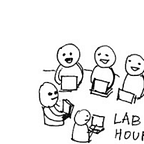Written by Ruth Johnstone and Izzy Ocampo
As the July heat swells in NYC, Code Societies, our three week Summer session, is commencing with a fresh cohort of incredible students. On Monday July 2nd, seated around the SFPC classroom, we introduced ourselves and shared an anecdote on how our names came to fruition. Code Societies leaders Melanie and Taeyoon opened by detailing first the history of the Westbeth compound where SFPC is based, and then the intentions of SFPC.
Westbeth Artists Community is a large complex which first housed the Bell research labs. The labs were critical in developing the early stages of electronic communication- with their work even evident in mobile devices we take for granted today. One prominent figure who expanded their career there was Claude Shannon, often known as the “father of information theory”. The parallels he drew between electricity and binary logic grabbed the attention of British computer scientist Alan Turing, and although unable to talk about their work at the time due to WWII military restrictions, they discussed the possibility of computers learning how to play chess or being able to truly think.
The building was sold to a collective of artists in 1970 as a live-work space, giving birth to its current name: Westbeth Artists Community. Since then it has fostered the creative process of many artists, including John Cage, Diane Arbus and Merce Cunningham. Due to Westbeth’s rich history, the complex is now a landmark- great for future preservation but meaning that external facade changes are restricted- evident in the lack of AC in the SFPC classroom.
Formerly being the origin of invention for many important technologies as well as an artists skill-sharing community, Westbeth feels strikingly fitting to host SFPC. We hear that the school started as a dynamic possibility space to imagine and cultivate new learning environments with and for each other, with a focus on the effect of culture and technical capability on social infrastructure. SFPC is a research group, artist residency, and a school with intentions inspired by Black Mountain College.
“Code Societies, their technology, and their infrastructure are as shaped by culture as much by our technical capabilities. We can have a voice in these systems if we choose to.”
These objectives can be seen exemplified in some past projects shown to the participants and in the three priorities set for this session:
- Learning
- Building community
- Having fun!
Code That Shapes Society Activity
After students got a slice of projects completed in SFPC’s previous sessions, they were challenged to think about about and illustrate a piece of code or technology that shapes society.
Students then paired up into groups of two or three, shared their ideas, and combined them to fashion a new code, technology, interface, or device.
Each group shared a large, blank sheet to diagram and showcase their individual and amalgamated codes.
SFPC’s Code of Conduct
Taeyoon and Melanie concluded the first day of Code Societies by introducing SFPC’s Code of Conduct which outlines constructive and respectful ways of being and learning as a class throughout the program. Taeyoon placed an emphasis on working openly with each other and being mindful of how much space one takes up in the classroom with the phrase “step-up, step-back”. Melanie encouraged getting comfortable with sharing risky ideas and awkward silences as they often lead to unforeseen challenge and growth.
